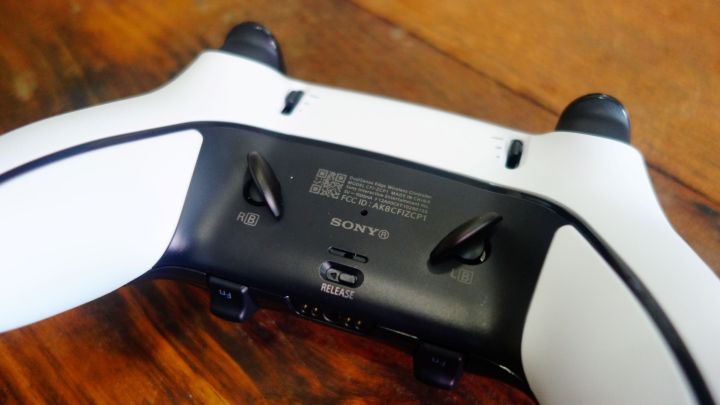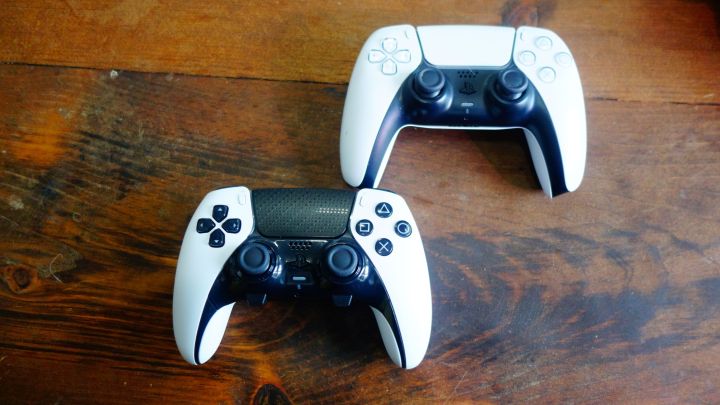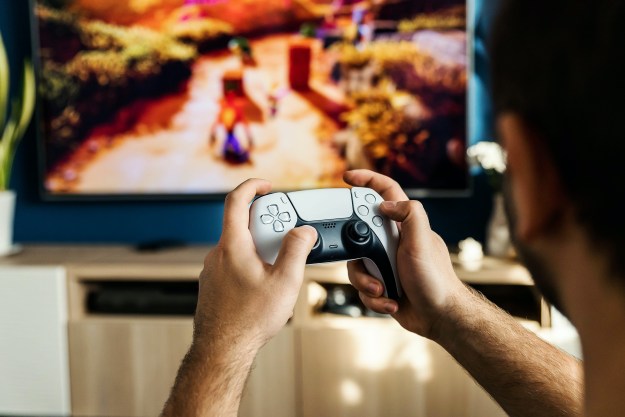
“The DualSense Edge offers excellent customization options for PS5 fans, but its high price point makes it a luxury purchase.”
- Strong build quality
- Sturdy carrying case
- Fantastic back buttons
- Versatile trigger locks
- Innovative profile swapping
- High price
- Short battery life
- Parts feel lacking for price
There’s a dirty secret about PS5 controllers: No matter how great a third-party one is, a Sony-developed one is always going to be best-in-class. That’s not because the company produces better hardware than PowerA, Victrix, or Scuf; it’s simply because Sony holds the patents for the DualSense’s signature features. No matter how innovative another controller is, you’ll only get haptic feedback and adaptive triggers on an official Sony gamepad.
That puts the new DualSense Edge at an inherent — and perhaps unfair — advantage. On paper, Sony’s new “pro” controller is more flawed than a lot of competitors that beat it to the punch. It’s expensive, has a short battery life, and comes with a limited set of swappable parts. On all of those points, it pales in comparison to, say, Victrix’s excellent Pro BFG. And yet, it’s sort of unmatched by default if you want your PS5 controller to function like a PS5 controller.
Though I have some mixed feelings about it, the DualSense Edge does offer PlayStation fans something the PS5 has been lacking since launch. It’s a robust controller that’s fun to tinker with and includes some of the best back buttons I’ve used on a gamepad. It sports enough useful bells and whistles that it’ll likely replace my standard DualSense, though its price tag makes it a hard sell considering that the PS5’s regular controller is already one of the best gamepads out there on its own.
Build quality
At first glance, the DualSense Edge looks almost identical to a regular DualSense … and that’s a good thing. Sony’s standard PS5 controller sports an “if it ain’t broke, don’t fix it” design and the Edge takes that device. In terms of aesthetic difference, it swaps the D-pad and face buttons from white to black. The touchpad gets a slight makeover here, with a black textured surface. The only major difference on the front is the inclusion of two function buttons, which are unobtrusively placed below each joystick.
There’s a lot that impresses me about the overall build quality here …
The backside brings some extra changes, though the Edge is careful not to clutter it. There are two magnetic slots for attachable back buttons, a set of trigger locks, and a small release button used to pop off the front faceplate. I appreciate that the Edge keeps its look simple. With a pro controller filled with features, there can be a tendency to overdesign and create an eyesore. Instead, the Edge feels like something I could hand to someone who’s never used one without triggering a lot of confused glances.
The Edge comes bundled with a black and white carrying case that neatly holds all of its attachments. A mesh pouch houses a wired cable, while a bottom compartment has slots for its extra joysticks and back buttons. As a nice extra touch, the inside of the case features a QR code that takes users to an FAQ page when scanned, acting as a digital manual. That packaging makes it safe and easy to transport around, which is a must for a $200 controller.

There’s a lot that impresses me about the overall build quality here, but there is one major caveat: battery life. The DualSense Edge pales in comparison to the standard DualSense when it comes to battery, based on our testing. We’ve gotten around six hours out of a single charge, which is a few hours shy of how long my DualSense lasts. Though I understand its extra perks might demand some power, it’s hard to stomach such a notable step down in what’s supposed to be a “pro” model.
Granted, most people don’t play a game for more than six hours straight and a lengthy cable makes it easy to play from the couch when it needs a charge. Still, users shouldn’t be making trade-offs with a piece of tech that’s more than double the price of what came bundled with the console. The DualSense Edge should feel like a step up in every way and this is one key area where it notably doesn’t.
The bells and whistles
The main attraction here is the extra level of customization the DualSense Edge provides. For those who love to tweak their settings, there’s a lot to experiment with here. For instance, I can change how far down each trigger needs to be pressed with a set of locks. Each trigger has three settings, much like the Xbox Elite Series 2, and I’ve already gotten some good use out of them. In Forspoken, I found that moving to the middle setting made it much easier to fling magical spells, which could get tiring after repeated full presses.
I can’t help but feel like Sony is a little too precious with its DualSense design here …
I’m most enamored with Sony’s approach to back buttons here. The package comes with two sets of back buttons: levers and half domes. Both easily slot in and out of the controller via magnetic slots, making them easy to install. More impressive is that I never feel like they’re in danger of accidentally falling out, despite the fact that all I need to do is pull to remove them. Both back button designs are unobtrusive and feel perfectly placed — something that lots of controllers struggle to nail — but I’m especially impressed with the half-dome buttons. They perfectly sit under my middle fingers and press in with a soft, satisfying click. Even when I’m not using them, they act as a natural resting spot for my fingers. The levers feel just as natural to use, but I’d love to see this style of back button to become standard for Sony controllers going forward.
The customization potential gets a little lacking from there. The only other parts included are four dome joystick caps that can replace the two standard ones that come with the controller. There’s a “high” and “low” version of each, though the height difference between them isn’t too noticeable. Installing them can be a bit tricky at first too, as joystick caps don’t simply pop off. To replace them, you need to slide a “release” button on the back of the controller to pop off its front faceplate. If you don’t have nails, this is a bit of a pain to pull off. I still can’t get it right without some fiddling.

Once the faceplate is off, you need to lift a metal level to release the stick module, allowing you to pop a cap on and off. Doing so disconnects the controller from the PS5, though, so it’s a bit of a pain to naturally pull this off in game if, say, you want to experiment with a different stick height mid Call of Duty match. I’ve gotten the hang of it and can swap a stick quickly, but it’s a bit more of a hassle than other similar controllers I’ve used.
That’s about all you can play around with in terms of hardware customization, which feels lacking when I look at other controllers I have sitting around. For instance, the Edge only has two back buttons whereas controllers like the Elite Series 2 have four. The Pro BFG comes with two fewer joystick caps, but it does include a much taller “sniper stick” as well as a set of hexagonal stick gates that give me a lot of mix-and-match potential. Here, I simply have the option to map two extra buttons and make a more subtle change to my stick layout. Personally, I prefer the standard caps that come with the DualSense and haven’t felt the urge to replace them after testing, but everyone’s mileage will vary there.

I can’t help but feel like Sony is a little too precious with its DualSense design here, clashing with the idea of a high-level controller built to give players more agency. For example, several gamepads at this price range come with different D-pad styles that can be swapped in and out. The Pro BFG includes a standard D-pad, an eight-directional one, and even its own original design. That’s not the case here, as Sony sticks to its four-directional face button layout. I’m just left wondering if that’s for a practical reason or if Sony is perhaps a little too protective over the DualSense’s aesthetic.
This might all sound like a nitpick, but once again, we’re talking about a controller that retails for the price of a Nintendo Switch Lite. If it sounds like my expectations are high, it’s because the bar for a product like this is. I just don’t feel like I have too much to play with on the front end, which is part of the appeal of something like this. The excellent back buttons do make this a worthwhile investment for those who swear by them, but I do feel like most players could stick with the already premium-feeling DualSense and not be missing too much.
Backend customization
Though I’m a little let down by the parts included, the DualSense Edge shines when it comes to its backend customization. When pairing one to a PS5, you’ll be able to alter a suite of functions via the console. That gets as specific as tooling around with trigger and stick deadzone, the kind of high-level tweaks that’ll really appeal to the kind of users who actually need something like this.
Its best feature, though, comes in the form of its button profiles. Via the settings menu, users can change every single button on their controller and save it to a profile. Want to make a few profiles featuring different back button mappings? Create as many as you want. Want to throw your face buttons on your triggers and bumpers? Weird, but go ahead! I mapped L3 to a back button, for instance, while playing One Piece Odyssey so I didn’t have to press a stick to toggle the game’s auto-run function. Once mapped, players can store up to four profiles on the gamepad which can be seamlessly triggered by holding down a function button and pressing a face button.
The back buttons and profiles are enough to notably improve my experience in certain games.
Here’s an example of how smooth that all is in practice. I created two separate profiles while playing Forspoken. One was my combat layout, which mapped a bumper to each back button. L1 and R1 open up Frey’s radial spell menu in the game, which is usually a pain, but felt much more natural on the half domes. I created another exploration-focused profile though, which maps the parkour and item pick-up buttons to the back instead. That would allow me to run more freely, focusing on my stick movements. When I run into a pack of enemies while exploring, I simply press function and circle to instantly swap to my attack setup. When I’m done, I just as easily press function and X to swap back.
That level of control is ultimately what wins me over with the DualSense Edge, despite its flaws. A good pro controller is all about offering players flexibility and that’s exactly what I feel when I flip between profiles on the fly. While I’d love to tinker with more buttons and parts, the reality is that the basic DualSense design is already top of its class; there’s not much I’d want to change about it even if I could. The back buttons and profiles are enough to notably improve my experience in certain games.

That feeling is most certainly a luxury though, and one that’s hard to fully justify at $200. If the Edge retailed for $50 less, it would be a no-brainer purchase for anyone who uses their PS5 weekly. It’s just tough to broadly recommend when it’s a step down in battery life and when its frontend customization is outclassed by cheaper, more innovative third-party models.
Though even after all of those criticisms, I return to my first thought: you cannot get adaptive triggers or haptic feedback on any of those controllers. The DualSense Edge is, in some ways, the only pro PS5 controller. If it doesn’t sound worth the price, it probably isn’t for you. But if you’re itching for an Elite Series 2 equivalent on
Editors' Recommendations
- Can you play PSVR games on PSVR2?
- Final Fantasy 16: release date, trailers, gameplay, and more
- Final Fantasy XVI turns accessibility options into equippable gear
- Best PlayStation Plus Deals: Save on Essential, Plus and Premium
- PlayStation VR2 adds even more games to its launch lineup







